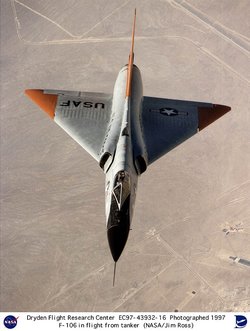Delta wing
|
|
The delta-wing is a wing planform in the form of a triangle. Its use in the so called "tailless delta", i.e. without the horizontal tailplane, was pioneered especially by Alexander Lippisch in Germany and Boris Ivanovich Cheranovsky in the USSR prior to WWII, although none of their glider and powered aeroplane designs saw widespread service.
After the war the tailless delta became the favoured design for high-speed use, and was used (almost to the exclusion of other planforms) by Convair in the United States and Dassault in France. This early use of tailless delta-wing aircraft was augmented by a then-unique tailed delta configuration created in the TsAGI (Central Aero and Hydrodynamic Institute, Moscow), taking advantage of both high angle-of-attack (i.e., manoueuvre) capability and high speeds. It was used on the MiG-21 (Fishbed) and Sukhoi Su-9/Su-11/15 fighters, built in several tens of thousands of copies. Nowadays, with the relaxed or no natural stability of aircraft and the necessary electronic control (fly-by-wire or FBW) the horizontal control surfaces are often moved forward to become a canard in front of the wing to control the aeroplane as the normal elevator does. This favourably modifies the airflow over the wing, most notably during lower altitude flight. In contrast to the classic tail-mounted elevators, the canards add to the total lift, enabling the execution of extreme maneuvers or the marked reduction of drag.
The primary advantage of the delta wing design is that the wing's leading edge remains behind the shock wave generated by the nose of the aircraft when flying at supersonic speeds, which is an improvement on traditional wing designs. Another advantage is that as the angle of attack increases the leading edge of the wing generates a vortex which remains attached to the upper surface of the wing, giving the delta a very high stall angle.
A normal wing built for high speed use is typically dangerous at low speeds, but in this regime the delta changes over to a mode of lift based on the vortex it generates. The disadvantages, especially marked in the older tailless delta designs, are a loss of total available lift caused by turning up the wing trailing edge or the control surfaces (as required to achieve a sufficient stability) and the high induced drag of this low-aspect ratio type of wing. This causes delta-winged aircraft to 'bleed off' energy very rapidly in turns, a disadvantage in aerial maneuver combat and dogfighting.
Additional advantages of the delta wing are simplicity of manufacture, strength, and substantial interior volume for fuel or other equipment. Because the delta wing is simple, it can be made very robust (even if it is quite thin), and it is easy and relatively inexpensive to build--a substantial factor in the success of the MiG-21 and Mirage aircraft.
Lippisch, Frenchman Payen, and the DFS studied a number of ramjet powered (sometimes coal-fueled!) delta-wing interceptor aircraft during the war, one progressing as far as a glider prototype. After the war Lippisch was taken to the US, where he ended up working at Convair. Here the other engineers became very interested in his interceptor designs, and started work on a larger version known as the F-92. This project was eventually cancelled as impractical, but a prototype flying testbed was almost complete by that point, and was later flown widely as the XF-92. The design generated intense interest around the world. Soon almost every aircraft design, particularly interceptors, were designed around a delta wing. Examples include:
- Avro Vulcan
- Avro Arrow
- Dassault Mirage III
- Dassault Mirage IV
- Dassault Mirage 2000
- Convair B-58 Hustler
- Convair F-102
- Convair F-106
- Eurofighter Typhoon
- Fairey FD-1 Delta
- Gloster Javelin
- Tejas
- North American XB-70 Valkyrie
- Lockheed SR-71 Blackbird
- Mikoyan-Gurevich MiG-21 'Fishbed'
- Saab Viggen
- Saab Gripen
- Sukhoi Su-9 'Fishpot'
- Sukhoi Su-11 'Fishpot'
- early Sukhoi Su-15 'Flagon'
Pure deltas fell out of favour somewhat due to their undesirable characteristics, notably flow-separation at high angles of attack (swept wings have similar problems), and high drag at low altitudes. This limited them primarily to high-speed, high-altitude interceptor roles. Some modern aircraft, like the F-16, utilise a cropped delta along with horizontal tail surfaces. A modification, the compound delta such as seen on the Saab Draken fighter or the prototype F-16XL, or the graceful ogival (or Gothic) delta used on the Anglo-French Concorde Mach 2 airliner, connected another much more highly swept piece of the delta wing to the forward root section of the main one, to create the high-lift vortex in a more controlled fashion, reduce the drag and thereby allow for landing the delta at acceptably slow speed.
As the performance of jet engines grew, fighers with more traditional planforms found they could perform almost as well as the deltas, but do so while maneuvering much harder and at a wider range of altitudes. Today a remnant of the compound delta can be found on most fighter aircraft, in the form of leading edge extensions. These are effectively very small delta wings placed so they remain parallel to the airflow in cruising flight, but start to generate a vortex at high angles of attack. The vortex is then captured on the top of the wing to provide additional lift, thereby combining the delta's high-alpha performance with a conventional highly efficient wing planform.de:Deltaflügel

